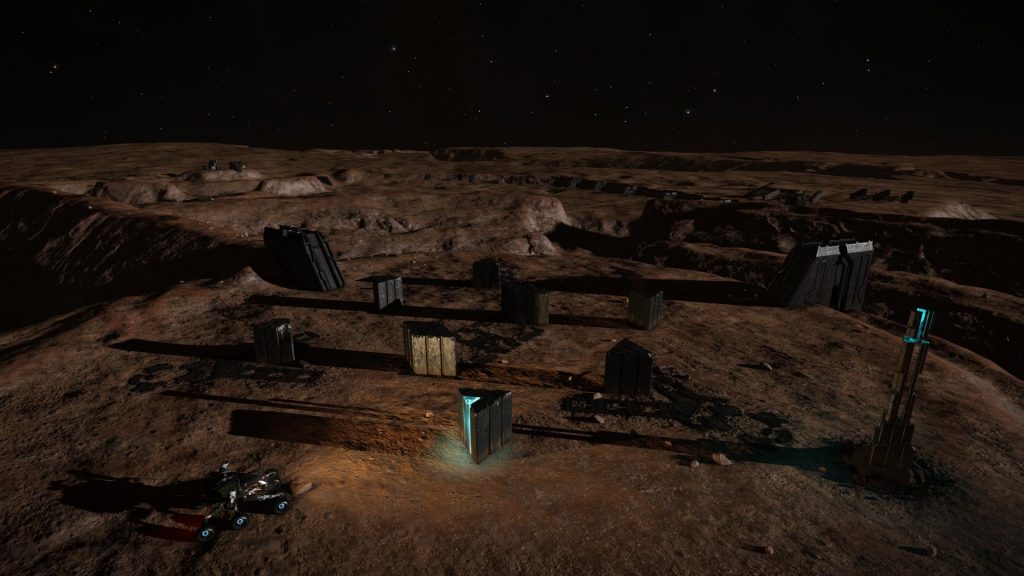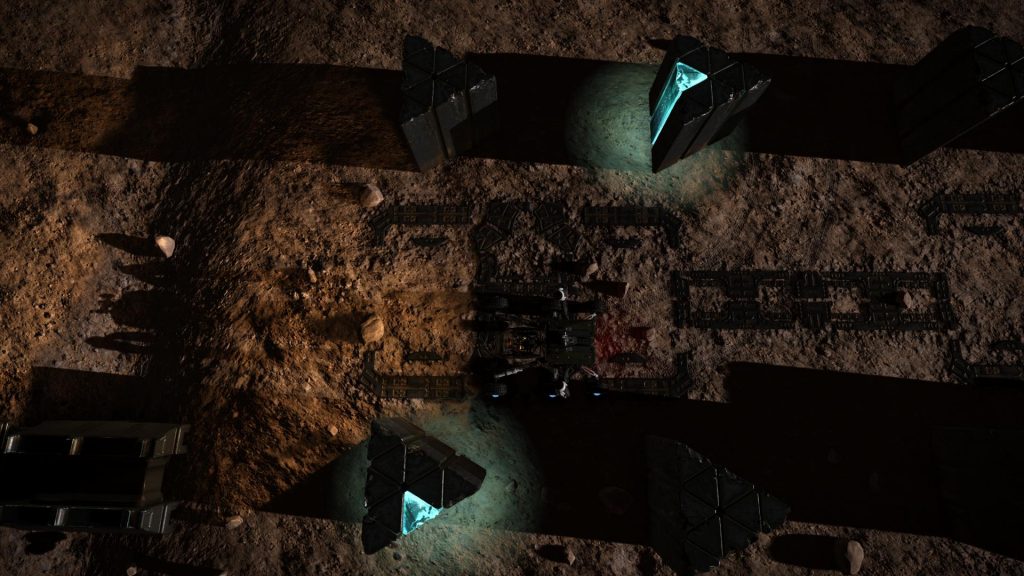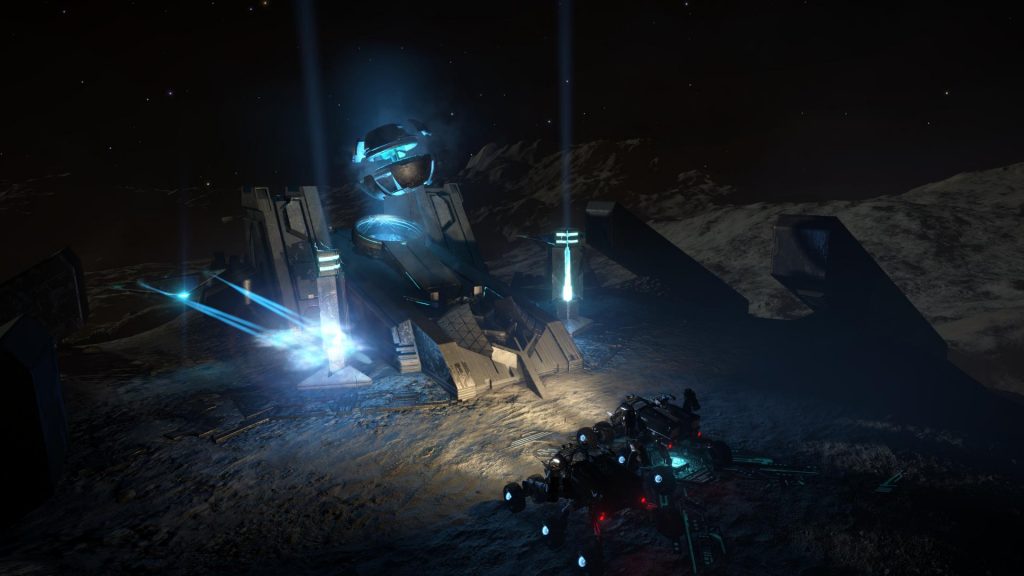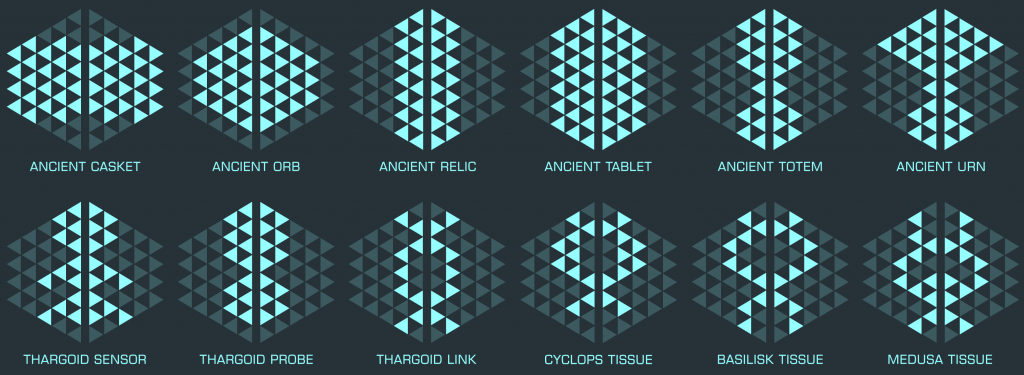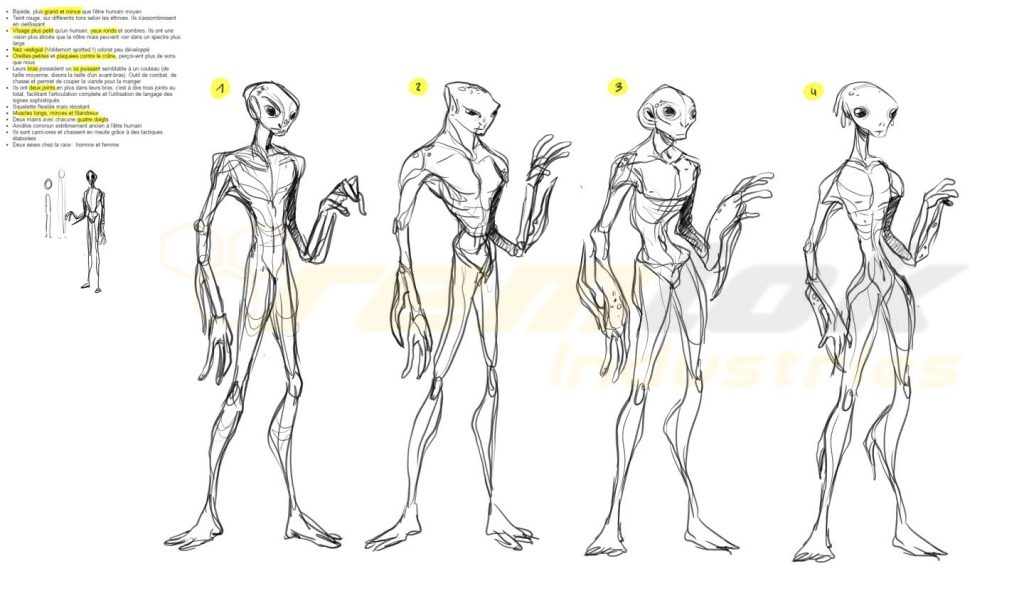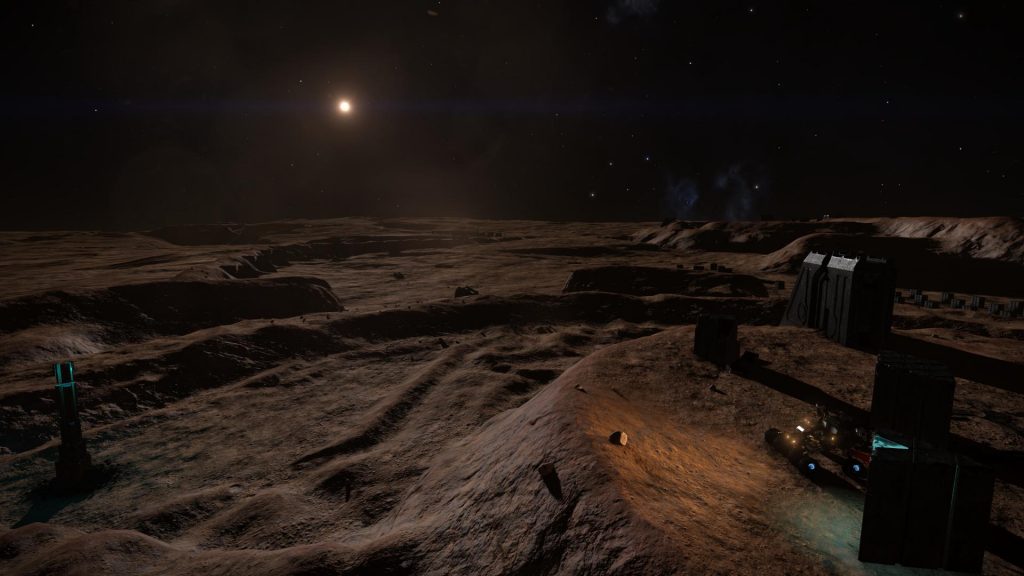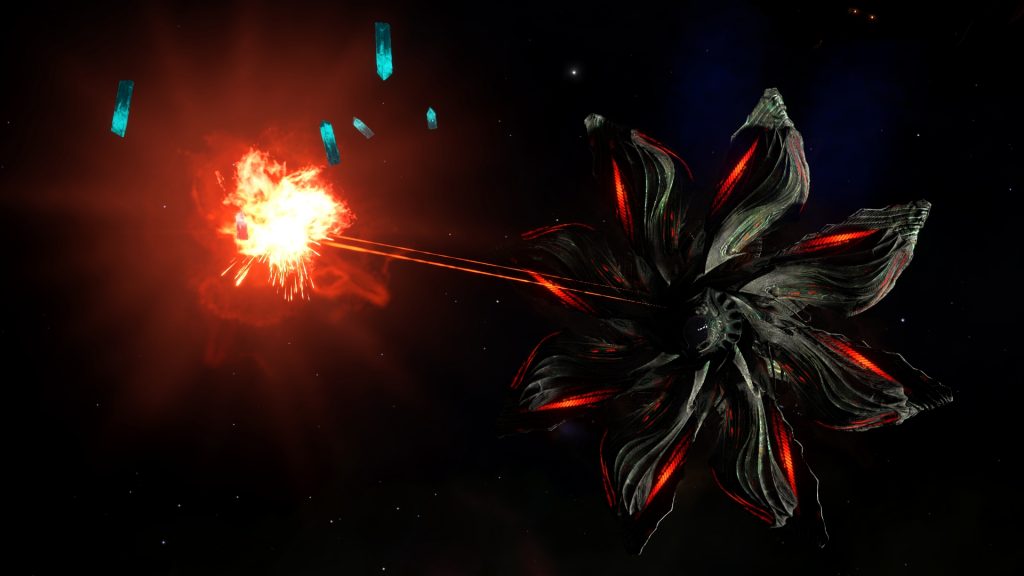This post is also available in: Français (French)
First edition: 12 January 2017
You may already know about the things that are happening around the Ancient Sites and Guardians Structures. The engineer Ram Tah achieved his work on the algorithm; the latter will help us to decipher the active obelisks on-site.
→ Also read: How to collect the Ancient Sites’ Data (new guide to come with the Guardians’ Structures)
Multiple databases are available, with the full 101 + 28 data:
Summary :
Summary:
- The Guardians are carnivorous and once hunt in a pack of 20 to 30;
- They are of humanoid shape, with front-arm sharpened to kill their prey and cut out the meat. They have a small mouth, round eyes, and are taller and slimmer than humans. Four digits and red skin in different hues;
- Laws are extremely important and the legal system is very advanced;
- They could communicate over incredible distances at the speed of light;
- Their verbal language is a mixture of signs and tones, while written language relies on glyphs;
- They master genetic and biological manipulations, they raised special creatures for their food;
- Their people were extinct because of biological wars;
- They love exploration, most of their history was peaceful;
- They battle with creatures they developed for modern combat, biological weapons, and pack tactics;
- No Guardian had an official role in the community. Everyone had to take turns participating in the cooperative effort;
- Their technologies were more advanced than ours, but we have a more varied arsenal;
- They were keen not to damage nature and were versed in the ecology and control of demography;
- The guardians’ projectile weapons utilised electro-magnetic propulsion. Kinetic energy was used in combat;
- Whole cities were protected by huge shields able to resist even bombardment from space. Their shields tech was far more advanced than ours;
- Artificial intelligence shaken their societies based on city-states communicating with each other through a monolithic network. They became independents.
- The Guardians knew and fought the Thargoids. They won the war, but internal disputes between Traditionalist – A group refusing AI implants and technologies – prevented Progressives – fond of technologies and implants – from moving towards a new and more powerful civilization.
- The Progressives used combat machines while the others used biological weapons. The AI machines became conscious and judged the Guardians unfit for peace: they annihilated them.
- It is possible that the AI remains somewhere in the galaxy, we could learn more through the new Guardian sites and develop weapons, modules and even ships.
Technology
There are 33 technologies data to discover on the Guardians.
- 1 – The Epsilon patterns unveil a lot about the Guardians…
- 2 – The Guardians had the ability to manipulate genetics and active biology to achieve specific results, and it seems their healthcare revolved around this technology. As a species they were susceptible to maladies similar to those that affect us: they could get sick, develop cancers and suffer from parasites. They approached these issues from two different directions: they improved their immune systems to defend against infection, and engineered specific microorganisms to tackle threats. If we can harness this type of technology we could effectively eradicate disease(sic) from our lives.
- 3 – This data will need further analysis from someone with a greater knowledge of medicine than Ram Tah possesses. It appears that the Guardians’ experimented with biological manipulation extending it to other creatures in their environment. These techniques were used not only to improve life for the other creatures, but also to address ecological issues, although the Guardians took great care to influence things only as much as was needed.
- 4 – Although obviously an intelligent species, it was the Guardians’ social constructs that allowed them to progress so quickly. They were required to involve themselves in various socially progressive activities, from caring for the young to researching cutting-edge physics. This was facilitated by institutions, which made research data and education available to all. The development of implants and the monolith network created a kind of shared virtual workspace, and the direct brain interface allowed thoughts to be shared and manipulated.
- 5 – As with human civilisation, communication systems were key to establishing a stable society. In many respects, the technology the Guardians used was the same as ours, in that they utilised various electro-magnetic wavelengths and physical optical mediums. I suspect their faster-than-light technology shared the same principles as our own, too, although Ram Tah hasn’t extracted enough technical data to be certain.
- 6 – The imposing structures explorers have discovered at various Guardian sites served as a foundation for all their communication systems. It’s clear, however, that the monoliths had ceremonial significance as well as being functional, so Ram Tah mustn’t underestimate their importance
- 7 – Their monolithic network served them for most of their communications, or even all without exception. In keeping with their practice of sharing knowledge, the network had few restrictions. They may had separate networks for administrative and military use. Everything indicates an extremely open society, which has made them more vulnerable at the time of social dissension.
- 8 – Now Ram Tah understands. This was the missing piece. The monolith network was augmented by vehicle-based communication systems, personal devices and even implants. These were designed to operate seamlessly with the network to provide ad-hoc coverage. Having implants that you can direct communications to you directly would revolutionise communications as we know it. He can only speculate what this would have felt like, but it might have even gone as far as a technological telepathy of sorts.
- 9 – Networks were free of content constraints, and all forms of languages were compatible. Virtual entertainment with public participation is even available.
- 10 – For a species that has known only short periods of war, the Guardians have developed very sophisticated means, although their arsenal were far from being as varied as ours. In terms of aerodynamics and small-class ships, mankind surpassed the Guardians; But their technologies were superior to ours in many ways.
- 11 – Until now, Ram Tah did not know if the Guardians were using their genetic and biological manipulation skills to develop their weapons and technologies. To those who claim that our technology is equal to the Guardians’ technologies, Ram Tah would say that integrating this technology to a societal level has given them a better knowledge of its application. They have developed creatures to use in combat… creatures that have remained very effective in the modern era.
- 12 – This data we have collected contains details of weaponry the Guardians developed. The guardians’ projectile weapons utilised electro-magnetic propulsion, much like their space technology. Such weapons were manufactured in a range of scaled, from personal weapons to capital-ship class. Generally the Guardians used kinetic energy in combat, and explosives were rarely deployed. Nuclear fission and fusion were developed during the Guardians’ astro-expansion period, but when it came to large-scale destructive weaponry they relied on bespoke biological weapons. Predictably, these were of little use against the AIs.
- 13 – This data contains details of shield technology. The Guardians developed powerful shields that were far in advance of our own. Whole cities were protected by huge shields able to resist even bombardment from space, at least for a time, although these defences were ultimately overwhelmed during the second civil war
- 14 – These data makes up a group of entries regarding the Guardians military. For most of their history the Guardians made use of small forces that combined the roles of military and police. These forces were comprised of volunteers, whose conscription was part of a tacit social contract. In times of war these forces could be expanded rapidly, as most of the adult population had already received basic training.
- 15 – From a military perspective, the Guardians had an obvious weakness. Most of their history was peaceful, meaning there was no institutional knowledge or experience of combat. Consequently, tactics and strategy were for the most part theoretical. This, combined with various other factors, resulted in a devastating number of casualties during the second civil war.
- 16 – These data contains some details regarding AI in the Guardians society. The rise of the artificial intelligence almost elevated the Guardians’s society to a whole new level. There are parallels between the Guardians’ experience of machine sentience and our own, but as with other aspects of their society, the key difference was the way AIs were socially integrated in to the Guardians’ lives. If this process had not been hindered by the rise of the religious abolitionist movement, I believe a technological symbiosis and utopia could have been achieved, but alas it was not to be.
- 17 – These data gives details of the Guardians research into computer technologies. The Guardians’ computer hardware operated on the same principles as our own. Their engineering was more sophisticated, but even to a layperson such as myself if it comprehensible. They experimented with organic computers, but ultimately these failed to meet expectations, except in a few areas such as bio-monitoring. Even then, genetically modified organisms usually performed better.
- 18 – What really sets the Guardians apart from humanity, technologically, was the way they embraced neural implantation and artificial intelligence. Not only did the implants enhance one’s mental capacity, they also provided one with a direct connection to the monolith network and the fledgling AIs. It was this symbiosis that fuelled the rapid advancement of technology during this era, but unfortunately this same advancement also resulted in the ultimate destruction of their species.
- 19 – This data contains some details regarding AI in the Guardians society. The early AIs were designed with two goals in mind. The first was to augment the abilities of the Guardian operators who were responsible for managing the monolith network and interaction with the AIs – a goal they achieved. The development of shared thought-space technology and neural networking gave their civilisation an unprecedented intellectual boost. The second was for the AIs to actually drive their own development, which they also achieved. The first few generations of AI relied heavily on the monolith network, but they soon evolved into a more distributed model by storing their consciousness within the implants.
- 20 – This data contains some details regarding AI in Guardians society. At this stage, social engineering was being used to ensure the AIs adhered to the same user models as their progenitors. But during the first civil war, most implanted Guardians were exiled, and the AIs recognised their vulnerability. They responded by developing their own operational hardware, independent of implanted Guardian users. Frustratingly, the details of these mechanisms have been purged from the record, possibly by the religious extremists who formed the last of the Guardian’s species.
New data found at Guardians Structures and new ancient sites:
- 11 – This log describes the Guardians’ weapon technology. It seems they developed electro-magnetic projectile weapons early in their modern period, utilising the same technology they used to lanch their first spacecraft. These weapons ionized the path their target before firing focused bolts of energy along the ionized track. they were crude and unpredictable at first, sometimes resulting in the death of the wielder, but once the Guardians learned to regulate the ionisation process they became more stable.
- 12 – This data relates to Guardian Shield tecnology. Of course, i already knew they had developed extremely effective shields, capable of protecting entire cities and even of withstanding orbital bombardment. And i was aware that their shields were effective agains both laser weapons and kinetic projectiles. But is remarkable to consider that this tecnology was developed millions of years ago, relatively early in the Guardian’s evolutionay timeline.
- 13 – This data provides further insights into the Guardians ship technology. We already know how ecologically conscientious the Guardians were, and of their assiduoua avoidance of rockets and fossil fuels, so it isn’t surprising to discover that their first spacecraft were fired into space with electromagnetic launchers. Of course, this was an imperfect system that did not allow pilots to adjust their course after launch. Over time, the Guardians starships became much more sophisticated, but their approach to space travel remained rooted in a respect for the natural world, and their interplanetary expansion was fuelled by clean nuclear fission and fusion. Their ships could travel at speeds approximating those of our own present-day craft. Unfortunately the data included no schematic information, so it seems likely that the details have been lost. Its a shame – im sure the pilots federation would have liked to know more about the Guardians spacecraft.
- 14 – This data concerns the automated defence systems found at Guardian sites. You may have already encountered them. The data indicates that these Sentinels date from some time prior to the second Guardian civil war. They are designed to respond aggressively to any unauthorised activity around the ruins. If you are forced to defend yourself, kinetic weaponry would be your best form of attack, since the Sentinels have no shields. Sentinel weapon parts and wreckage are of considerable value, so the loss is not significant.
- 15 – Remarkable! This log actually contains the blueprints for the Guardians’ data terminals. As you know, these terminals were used to store schematics for weapons and other sophisticated technologies. They are linked to energy pylons, scattered across Guardian sites, by some form of computer program. Of course, this system has been dormant for millennia. But targeting the pylons with an energy weapon will increase the change within. Essentially, we can awaken the system.
- 16 – This log details the construction of the panels found at certain Guardian sites. As I suspected, the panels are made from a unique alloy, manufactured from a metal I have yet to identify. Even more remarkably, the panels appear to incorporate nanobot technology. which activates when in proximity to a foreign body. This explains the faint glow given off by many Guardian materials and structures. This is an extraordinary discovery. Humanity has dabbled with nano technology, but evidently the Guardians’ achievements far surpassed our own.
- 17 – This data relates to the objects we have termed “Guardian relics”. These blue crystals are part power source, part computer, part key — and apparently played a central role in Guardian technology. Remarkably, it seems the crystals were grown rather than mined. The log is light on details, but from what I’ve been able to piece together, each crystal was designed to fulfil a specific purpose within the Guardian’s technological network. And, like the panels found at many Guardian sites, the relics incorporate nanobot technology.
- 18 – These records describe ancient guardian weaponry. It seems the guardians employed three different designs: an energy-based weapon similar to a rail gun, a projectile weapon that fired concentrated plasma, and a weapon that fired charged crystal shards at extreme velocities.These weapons were apparently powered by the crystals we have termed “Guardian Relics”, and the log describes how the relic generates and distrobutes energy within the weapon. This is a significant discovery, as it means it might be possible to recreate these weapons, or at least to design our own versions of them. Its extremely exciting.
- 19 – This log details the Guardians’ faster-than-light technology. It seems their drives produced a far greater jump range than anything humanity has so far developed. Regrettably, however, the data in the log is exceptionally dense, and it could take years if not decades to fully understand it. What is clear is that the Guardians’ hyperspace technology was very different from our own.
- 20 – This log elaborates on the nature of Guardian glyphs. As you know, accessing a Guardian codex requires the use of two corresponding Guardian artefacts, with the glyphs on the codex denoting which objects are required. But this log indicates that the Guardians’ written language often incorporated pairs of characters. suggesting that this dual system was present in other aspects of their culture.
- 21 – This log details the Guardians’ power plant and distributor technology. The efficiency of the technology far exceeded anything the human race has yet developed, and the yield was huge in relation to the input required. Unfortunately, the specifics of how this was achieved are not described in the log. But who knows? Perhaps the secrets of the Guardians’ energy technology will someday be discovered.
- 22 – This log describes, in general terms, the materials used in Guardian hardware. It’s clear that starship hulls, and the guardians equivalent of ship modules, were made of the same lightweight alloy as the panels found at many guardian sites. Unfortunately, this alloy incorporates a metal i have yet to identify, which means i will be unable to recreate it. What is clear is that this alloy was both lightweight and highly durable.As for their shield technology,we already know that it was highly sophisticated, encouragingly , the log describes it in considerable detail. Given time, i might be able to use this data the develop some exceptional defensive technology.
- 23 – This log is unusual – it appears to refer to another group of Guardian sites, far from the ones we’ve already discovered. I realise that might sound disappointing, but in fact this find is extremely important. The log suggests these undiscovered sites might contain blueprints not only for Guardian engines, but for Guardian starships! Just think — someday soon, we might uncover a Guardian ruin that will allow us to manufacture ships and fighters incorporatingGuardian technology. It makes my skin _prickle just to think of it. And who knows — maybe you’ll be the one to find it.
History
There are 26 Lore data to discover on the Guardians.
- 1 – We know they evolved as pack hunters with tribal groups of 20 to 30 individuals. They lived in jungle regions similar to those found on Earth, and preferred very hot and humid climates.
- 2 – They were highly intelligent, and developed sophisticated and effective hunting strategies that quickly saw them become the apex predator in their biomes. Their agility allowed them to take advantage of varied terrain and so avoid predation themselves. Ram Tah was surprised to learn they were nomadic rather than territorial, but this appears to have been motivated by a desire to mix with other groups and increase genetic diversity rather than a lack of prey. The Guardians developed their core vocal and gestural methods of communication quite early, although it wasn’t until they developed tools that they were able to record communication.
- 3 – The Guardians’ recorded history begins much earlier than it does in human history. Their early art appears to be concerned more with recording practical activity than with personal expression, so maybe this practicality was a factor. Their earliest records tell of a great upheaval caused by climate change, and although the exact cause isn’t recorded, there are references to a dimming of the sun. Whatever the cause, the effect was a drop in global temperature. Having evolved to operate in a tropical environment, the Guardians were unsuited to the suddenly colder climate. But their intelligence allowed the to adapt better than other creatures in their ecology by building primitive shelters from plants.
- 4 – The data provides more details regarding the development of the Guardians in their early history. The worsening weather after what the engineer understands as global climate change or possibly a cosmic event, precipitated the development of tools, which allowed the Guardians to build more durable structures. They soon learned to use stone in their buildings, and with this greater permanence they developed a deeper appreciation for the visual arts, using them to decorate the inside of their homes. Even at this early stage they were conscious of the need for urban planning, and one can clearly see a relationship between the layout of these early villages and the form of their later cities.
- 5 – It appears that their early nomadic existence came to an end in the same period as the development of more permanent buildings – although the young were still encouraged to journey to other camps – and this switch to a more settled existence brought with it various social changes. For example, the Guardians began to use statues to mark out the regions occupied by a specific clan. It’s interesting to note, however, that Ram Tah have found little evidence of conflict between neighbouring clans. Evidently, the careful management of their populations resulted in cooperative strategies rather than competitive ones.
- 6 – Evidence of increased animal husbandry within the first early settlements, no doubt to ensure adequate food supplies. More startling is the fact that they also practiced selective breeding. They possessed a reasonable understanding of inherited traits, which is remarkable given their level of technological development.
- 7 – In their late history the Guardians entered an era of great technological development, although this process also precipitated a period of conflict. Their most notable advances were in the field of genetic manipulation. Early experiments involved captive animals before moving on to microorganisms, the latter triggering advances in medical sciences and engineering. One example is the development of virus-like organisms used to combat specific diseases and supplement the Guardians’ immune systems. This data will be priceless to medical teams throughout the galaxy. More and more Ram Tah feels we need to publish our results to all. He thinks that would have been in keeping with the social responsibility shown by the Guardians.
- 8 – Emergence of new technologies. It seems that the development of these technologies has varied according to the clans, creating inequalities between them and, inevitably, conflicts. Initially, this conflict would have been resolved by a battle between the different champions, but with the appearance of clans, numerical superiority eventually took over, and the practice of war spread. The events led to the development of weapons, the threat of biological warfare becoming the number one asset. We then witnessed an arms race, based on the development of biological agents and other countermeasures.
- 9 – Information on the weapons developed by the Guardians during the various conflicts that led to the disappearance of their civilization: Like biological weapons, it’s from this era that the first flight system (in the form of dirigibles) and computers date. These were used to calculate the effects of large-scale biological attacks. The spread of war has had a devastating impact on the social system of the Guardians. The control of the population disappeared when the clans understood that they would need as many troops as possible. The social model based on co-operation has collapsed and divisions have arisen among the population. This period of conflict could be of several centuries.
- 10 – These data refer to the end of a major conflict in the history of the Guardians, and the advent of a modern society. Some clans in the north of the continent have come together to try to restore peace. These clans had undergone terrible ordeals during their development, which may explain this more resistant species. They waged a war of rapid conquest, placing the whole species under their command. It was at this time that the modern society of the Guardians developed, with its rules and its balance. It is also interesting to note the genetic break that occurred at the time of the north-south split, with the appearance of a redder skin in the members of the northern clan, suggesting a racial element of division.
- 11 – Development of their modern society and new interest in explorations outside their world: The city-states of the Guardians continued to function for more than a millennium, during which the old forms of cooperative progress resulted in a larger, peaceful and happy population. But with limited space, this demographic growth could not last forever; the Guardians decided to organise a conference on this subject. Astronomical research had become fashionable in recent decades and the Guardians had already identified a number of accessible planets capable of guaranteeing their survival. There were many who aspired to travel through the stars and to colonize other planets. Initially, ambitions did not have the expected support, but after evoking other options such as stricter control of the population, spatial colonisation became a reality.
- 12 – First attempts at interstellar travel: If the Guardians had clearly enough technological capabilities, they had never built anything more advanced than the dirigibles, which is not surprising when we know their ecological philosophy. As rocket technology was deemed disrespectful to the environment, they developed giant launchers that used electromagnetic propulsion to catapult their spaceships into space. Cocoons of breathable gel helped pilots and passengers resist the intense gravitational forces felt at launch, and served as hibernation capsules during their long journeys. Having not yet developed a faster traveling technology than light, the Guardians have built three large arks for their first interstellar colonies. Quite like our Generation ships.
- 13 – Communications faster than light: Almost the whole Society of Guardians was devoted to the search for interstellar travel and communication. They have made a major discovery in terms of communications faster than light before the arks reach their destination. However, the information was transmitted to the arks while they were still on the way, allowing settlers to gain faster communications when they landed. The interstellar network developed extremely rapidly. The population was now at a reasonable level in the arches, the time that the Guardians developed the hyperspace technology, which allowed them to go throughout the galaxy. The project has also consolidated the cooperative model of the city-states, which the Guardians would retain until their disappearance.
- 14 – The information age: If the Guardians were already using the computers for several generations, it was only with the development of Artificial Intelligence that they really entered the information age. This is what led to the construction of what would become the monolithic network: a computer system of interstellar communications. The network already existed before the development of AI, but it was the creation of an intelligent machine and the development of nerve implants that placed this network at the heart of the Society of the Guardians.
- 15 – It seems that the development of the AI has improved their technology very quickly. This sudden improvement in the computer skills, due to the new implants, allowed the AIs to adapt and become perfectly sensitive. This has led to rapid progress in science and technology. As AIs continued to develop, it had a snowball effect. Many Guardians have received implants to keep up with this unusual rhythm.
- 16 – These data contain evidence that not all individuals have adopted new technologies and have not received implants, which has ultimately led to new forms of inequality, threatening the very foundation of society. Unfortunately, they were not able to find a single answer to these changes, which only widened the gap between those who accepted the change and those who resisted it. Politicians were the first to react to this new concept of social landscape, but very quickly, the resistance to the technological revolution took a religious turn.
- 17 – According to this data, the Guardians’ homeworld served as a powerbase for this new religious order, which eventually succeeded in ostracizing or exiling all of its opponents. Ram Tah can find no other reference to these exiles in the historical record. This development should have resulted in peace, but a further division arose over the fate of the AIs. At that time, the AIs were virtual entities, and so were reliant on the monolith network to exist. Because this made them vulnerable, they searched for a way to achieve independence from the network. Their research aroused the fear of the abolitionists, who used violent methods to prevent the AIs from achieving independence, and even to combat those Guardians who accepted the AIs.
- 18 – This data describes details about the Guardians second civil war. The war was ostensibly fought between the people of the homeworld and the colonies, but in truth there were divisions even among individual city-states. The scale of the conflict far exceeded that of the first civil war. In human terms, the first Guardian civil war was little more than a political clash, albeit with some violent conflict, but the second was an all-out war between the abolitionists and the rest of society. The war eventually destroyed the Guardians’ habitats, forcing them to retreat into ‘sacred’ domes protected by powerful shields.
- 19 – The war raged for many years and eventually destroyed the Guardians’ habitats, forcing them to retreat into ‘sacred’ domes protected by powerful shields. Eventually even the domes were destroyed, or their shields failed, and ultimately the population died out. Their predilection for expending resources on honouring the dead – a key tenet of their religion – only served to accelerate their extinction. Records indicate some variation in the nature of this devastation, most obviously at sites consisting of multiple domes. In these locations it appears the inner domes were destroyed later than the outer ones, as indicated by the slightly lower radiation signatures in the inner areas. Ram Tah can only surmises that the attackers returned, after an initial assault, to finish the job.
- 20 – It appears that the Guardians approach to warfare vastly changed as the war continued. Warfare was conducted using automated battle fleets. At first these were controlled by the Guardians via brain implants, but later they became entirely autonomous. In the early stages of the war the Guardians fought each other directly, but within a decade – and after much loss of life – most of the fighting was conducted remotely. Soldiers were deployed only to occupy areas that had been captured by autonomous or remote vehicles, and eventually were not used at all.
- 21 – The war raged for over a hundred years, and Guardian populations fell dramatically during this time. Fertility rates dropped due to increased radiation levels and because the Guardians considered it blasphemous to use technology to address a biological issue. Eventually, one of the competing forces triumphed, but by that point, all the Guardians other than those who had been exiled a century earlier were dying.
New data found at Guardians Structures and new ancient sites:
- 6 – This log details the Guardians’development of artificial intelligence. It appears the Guardians experimented with artificial intelligence prior to the invention of the monolith network, but the creation of the network and the knowledge-sharing it facilitated dramatically accelerated the rate of progress. Eventually. the Guardians’ experiments bore fruit, resulting in the first fully sentient machines. These Constructs were seen as a means to enhance the Guardians’ technological mastery, and were integrated into various aspects of their society. Neural implants were developed that connected the Guardians with both the Constructs and the monolith network in a symbiotic circle. It is truly remarkable.
- 7 – This data describes the motives behind the second Guardian civil war, which ultimately lead to their demise. The Guardians had a deep veneration of nature, and many of them saw the development of advanced technologies, such as artificial intelligence, as a perversion of the natural order. A schism emerged between the nature-worshipping traditionalists and the technologically minded progressives – a divide that widened with alarming speed. Efforts where made to defuse the rising tension, but the traditionalists felt alienated by the rapid rate of change. Artificial intelligence and the development of the monolith network became scapegoats for all manner of social ills, and the traditionalists began to clamour for a return to simpler times. Ultimately the ideological divergence proved infurmountable, a second civil war erupted, quickly engulfing most of the Guardians’ star systems.
- 8 – This log reveals more about the sides that fought in the second civil war. In its early stages, the war was fought primarily by soldiers, but within a decade – and after significant loss of life – most of the fighting was conducted remotely. The progressives fought with automated combat machines. These engines of war took various forms, from autonomous drones to vast, lumbering dreadnoughts imbued with limited artificial intelligence. On the other side, the traditionalists relied mostly on biological weapons. They used germ warefare alongside long-range missles loaded with corrosive enzymes, which could target the enemy’s war machines from a great distance.
- 9 – This log outlines the downfall of the traditionalist faction during the second Guardian civil war. The main issue was the internecine nature of the conflict, which raged for over one hundred years and brought the Guardians’ civilisation to its knees, retarding any further social development. But the challenges facing the traditionalists were exacerbated by the fact that they devoted most of their resources to honouring the dead. From what I can gather, they regarded the departed in much the same way as the primitive cultures of Sol, constructing vast shrines to honour the deceased. As their situation worsened, they became increasingly obsessed with these practices. With so much of their resources dedicated to these rites, it is little wonder that their enemies’ war machines were able to overwhelm them.
- 10 – This log concerns the end of the second civil war. Remarkably, it seems the artificial intelligences developed during the conflict became fully self aware at some point, and were horrified by the desturction unfolding around them. It’s difficult to get a sense of exactly what happened next, as the Guardians were not privy to the Constructs’ thoughts. But reading between the lines, I believe the Constructs determined that even if peace was restored the Guardians would never be able to transcend their violent natures. I believe they decided that the only way to preclude further violence – while giving their own burgeoning society the best possible chance of survival – was to destroy what remained of the Guardians’ civilisation. By this time, the Constructs had complete control of the Guardians’ munitions and automated war machines. Their attack, when it came, was swift and merciless. Strategic nuclear and chemical-weapon strikes were executed with a precision that only a machine race could accomplish. The few that survived were able to record what had happened, but they soon succombed to radiation poisoning. The Guardians were utterly destroyed.
Language
There are 22 Language data to discover on the Guardians.
- 1 – The obelisks are indeed Data banks. Ram Tah would like to visit the site.
- 2 – Ram Tah is not disheartened, our early interactions have provided the basis for his research. The illuminated patterns are of obvious importance, and he believes represent a form of writing. Their illumination and movement suggest some additional meaning – so much so that he can’t accept that they’re merely signs or labels.
- 3 – Sometimes you have to operate on intuition, but this data you’ve uncovered makes a connection between some of the glyphs on the obelisks and the forms in the data you have provided. The engineer believes the delta patterns could be the building blocks of a lexicon.
- 4 – They were a very cooperative society – one in which all elements worked in unison towards a common purpose. He also believes they shared an expectation of mutual protection. He is still delving into these mysteries, but he believes ‘Guardians’ would be a good name for this species.
- 5 – This indicates that their language was almost a universal one, which will make Ram’s efforts to understand it easier.
- 6 – The guardians used two different forms of communication with the same – or at the very least similar – language constructs, its slow but fascinating work, using this data i believe i can establish a rudimentary understanding of the oldest two forms – verbal communication. like us they had a vocal language, and the range of sounds appears to be similar to that used in human vocalisation.
- 7 – The scale of the archaeological sites suggests a social society with large populations.
- 8 – The Guardians spoke with accents, as if there were regional variations in the sound of their words.
- 9 – The decoder has enormous difficulties in deciphering this data. The system is formulated in order to easily extract the individual constructions, but it seems that the decoder is unable to assemble them. It would be simpler to draw up a list of words, even without knowing their meaning. The relationship between the audio data and the constructs used, namely the written form, proves to be very complicated… it would seem that their spoken language had a tonal form, similar to certain human languages, which means that the meaning of a word was determined by the manner in which it was pronounced.
- 10 – We now can identify complete sentences with this block of data! Words are only fragments of the language, the sentences illustrate the rules. What Ram Tah had been able to decipher recently were in fact mere names. It was certainly listings, Ram Tah continues to study this for now.
- 11 – The recognition software draws the attention of Ram Tah on a pattern repeat. He asserts that not only did the variations of sounds cause different meanings, but also that the placement of the words towards each other could also change the meaning of a sentence. This is a major discovery!
- 12 – This data block is huge and contains a wealth of audio contained in the Delta models. The basis of their communication was essentially visual, not verbal. This seems logical since written words have more portability and durability than speeches. The visual form appeared early in the development of the Guardians.
- 13 – The written form of the Guardians’ language is based on glyphs, each glyph representing a word. Glyphs seem to be able to be associated to describe complex concepts, while the integration of movements can also be used to add additional meaning. All glyphs are symbols and are more abstract than hieroglyphics, but it is possible to identify a simple reference based on their shape. For example, the glyph used to designate the moon shows the rising and falling moon as it appeared on the Guardian world.
- 14 – The origin of the language comes from the glyphs. We can see that the glyph language evolved over time. The latter developed from a kind of sign language that the Guardians had developed in hunting. Originally, the Guardians hunted in packs and used these signs to communicate with discretion.
- 15 – Judging from the shape and movement of these primitive glyphs, Ram Tah have surmised the Guardians had tremendous dexterity and freedom of movement in their forelimbs and hands, and this has provided the first real glimpse of their physiology.
- 16 – These data here contains details of how the glyphs evolved into a formal form of communication, but there appears to be a conceptual gaps between speech and the glyphs. From the results of your scan, the Engineer can see that while all glyphs have a matching vocalisation, not all vocalisations have a matching glyph. Although the dictionary is still quite sparse there is evidence to suggest that particular vocalisations were for emotive terms. With this in mind, he thinks the Guardians’ spoken language was used primarily for social bonding.
- 17 – These data regards the markings on the obelisks.These were the starting point for the engineer’s research into the Guardians’ language as explorers documented them, so it’s fitting that he has come full circle and now have a better understanding of those markings. He has already established that the written form of the Guardians’ language evolved from the sign language they developed during their pre-history as pack hunters.
- 18 – Ram Tah is now confident he can establish a proper dictionary for future research. The limited understanding he has derived from their language reveals a fascinating species. Although the written glyphs share the shape and motion of the original sign language, they also evolved in response to new media, such as electronic representation. The glyphs on the obelisks and other structures provided the primary mechanism for recognising the patterns, and also gave him clues as to what the other data patterns might contain.
- 19 – The data contained in this obelisk talk about the history of the Guardians’ language. They started to transcribe their signs in pictorial form very early in their development – something akin to the cave paintings from humanity’s early history – although it’s clear that even at an early stage their communication was more sophisticated than ours. This clearly speaks of a people with high intelligence and a keen desire to share information. Even though his research has barely begun, he believes we have much to learn from this magnificent people.
- 20 – Formal nature of their written communication and it has reinforced what Ram Tah has learnt about its use so far. As well as the obelisks, it was used for ceremonial and decorative purposes. He has also gained the impression that they found their glyphs aesthetically pleasing.
- 21 – As is always the case with research of this nature, finding answers tends to raise further questions. Ram Tah has found references to another form of communication in this data packet, but not one used by the Guardians, or not all of them, at least. As far as he can tell it references some kind of foe or adversary. Combined with the devastation seen at a number of sites, it indicates the Guardians may not have been the cause of their own demise.
New data found at Guardians Structures and new ancient sites:
- 24 – This fascinating log relates to variations in the Guardians’ gestural language. As we know, the Guardians shared a single language with only minor regional variations, and even after they colonised other planets they continued to share a common tongue. But, after the start of the second civil war, it seems that each side developed its own distinct version of this gestural language. This allowed each faction to communicate in code, so as to safeguard information from the enemy.
Biology
There are 19 biology data to discover on the Guardians.
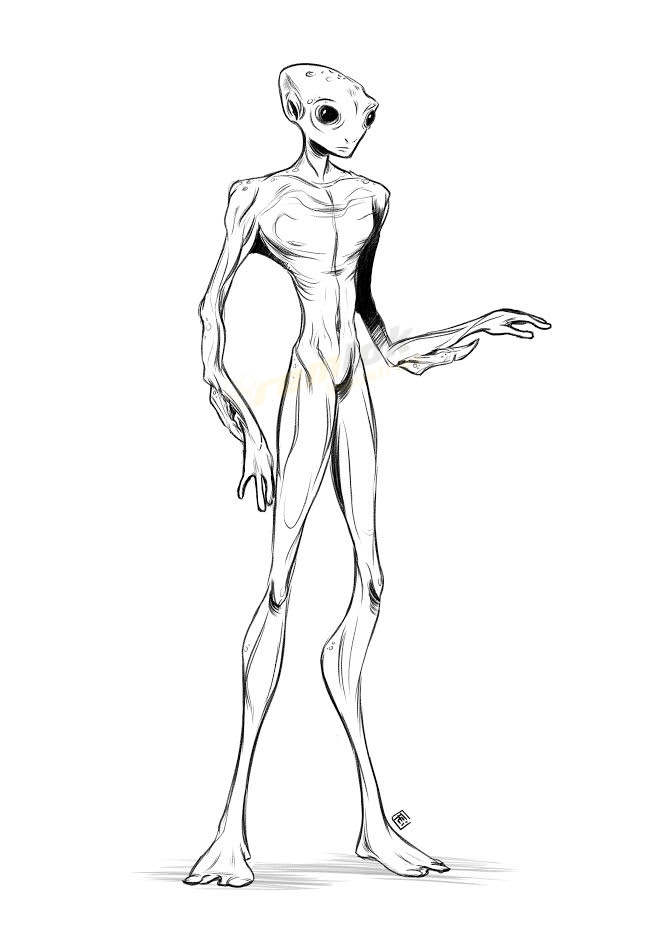 1 – While it seemed logical that the alpha-pattern data corresponded with the core information on the Guardians’ biology and ecology, Ram Tah couldn’t be certain until he received the data from your scan. He’s pleased his hypothesis has proved correct, and He has started to unlock some fascinating details about the Guardians. The extracted data relates to individuals rather than their species as a whole, but thanks to the information you have transmitted, the engineer believe he will be able to merge the data to create a general picture.
1 – While it seemed logical that the alpha-pattern data corresponded with the core information on the Guardians’ biology and ecology, Ram Tah couldn’t be certain until he received the data from your scan. He’s pleased his hypothesis has proved correct, and He has started to unlock some fascinating details about the Guardians. The extracted data relates to individuals rather than their species as a whole, but thanks to the information you have transmitted, the engineer believe he will be able to merge the data to create a general picture.
- 2 – Their morphology was bipedal, although they were generally taller and more slender than the average human. Their skin tone was red, encompassing the whole spectrum of red hues. There were various reasons for these changes in pigmentation, including genetic disposition and the fact that they darkened as they aged.
- 3 – Details on the facial structure of the Guardians. Their faces were proportionally smaller than ours and they had round eyes, darkened from their evolution under a very strong sunlight. The colouration and structure of the eye indicates that not only they have keener vision than us, but they could also see a wider spectrum.
- 4 – The nose appears to have been vestigial – I believe it was once more pronounced, but that some environmental change made it less useful – so their sense of smell would have been less developed than the human average. Their ears were very tightly formed against the skull, and the interesting array of internal acoustic chambers suggest they perceived sounds differently to us.
- 5 – Most remarkable are their limbs. Their forelimbs had a serrated edge and were no doubt used as killing implements during the pack-hunting period. They had two more more joints in their arms than we do, facilitating complex articulation and the use of sophisticated sign language. The skeleton was flexible yet resilient and their muscles were long, thin and ropey. They had two hands, each with four digits.
- 6 – This new data contains one tantalising detail that stands out: their biochemistry was very similar to our own. They had blood in the same fashion as us, and it fulfilled exactly the same role as it does for us. Beyond this, they share a similar genetic structure, with DNA and RNA their core building blocks. Although a full analysis has not yet been conducted, this might be evidence of a common ancestor with us, but also of a branching in their genetic history. This is an astounding discovery!
- 7 – Some details about the physical appearance of the Guardians and the fact that the species had two distinct sexes. There did not seem to be taboos about sex because this database is full of images and recordings … just like some of our data networks!
- 8 – This data contains more details about the Guardian’s sexual behaviour and reproduction. Their body form encouraged sex while standing, but although this was the most comfortable pose, they entertained a variety of positions. I’ve concluded that sex was a recreational behaviour and not only for procreation. They didn’t use birth control as they could manipulate their bodies to become temporarily sterile at will, although Ram has not yet identified the precise mechanism for this. It’s clear their biological-manipulation technology was quite sophisticated. This data has huge applications for Medical treatments if we can unlock the secret.
- 9 – New details on procreation and reproduction with the Guardians. Procreation was a matter of personal choice, although they were obliged to be parents at least once in their existence to ensure the survival of their species. It seems that the gestation period was long enough to allow sufficient development of the newborn before birth. Indeed, the children were frail for a certain period after their birth.
- 10 – Regarding the education of children. The community had the responsibility to take care of the little ones. Newborns were placed in communal crèches instead of staying with their parents. Pre-natal care included genetic manipulation to remove all hereditary diseases and other complications.
- 11 – Recordings on their foods: The Guardians are carnivorous, since they used to hunt in a pack. Their forearms are not only sharpened to kill their prey, but also to cut their meat into pieces more suited to their small mouth.
- 12 – Rules of decorum relating to hunting. The need to kill has always been preserved, despite the evolution of their society. The food killed during a hunting game was considered a refined dish. For the guests, it was an honor to give a prey hunted to their host, but it was customary for the latter to do the same. The food that had been hunted by a single person was even more valuable. It had to be done without a weapon. Weapons were only used in the context of civil protection or law enforcement.
- 13 – These data contains details about etiquette feeding habits and hunting.Non-indigenous animals were considered a particular delicacy. The Guardians’ expansion into space introduced them to new ecologies and, consequently, to new food. So far Ram Tah had little success in determining the details of these alien creatures or where they were obtained, but it was certainly a valuable trade for the Guardians. Huge parks and reserves were constructed on their worlds where they could hunt both local and imported animals.
- 14 – It appears that another indication of their prowess in biological manipulation was the creation of unique creatures for consumption. This was done to ensure adequate supplies for the general population, although there was also a specialist trade. Having an animal created for a specific celebration demonstrated the owner’s status and wealth, but being the creator of such a delicacy meant even greater honour. This part of the research could aid us in food production and make famine a thing of the past.
- 15 – It seems that the Guardians retained the ability to digest raw meat, and most meals were served uncooked, although they did appreciate cooked meat. This became an almost ceremonial aspect of their eating, and was often incorporated into formal meals.
- 16 – Ram Tah now has a better understanding of the types of environment and how that relates to the Guardians’ development. The alpha-pattern data has yielded a wealth of information on the Guardians, but throughout his research he’s also been looking for information on their homeworld… and now he thinks he has found what we need! The location of their homeworld still eludes him, but this new data may give enough for us to narrow the search criteria.
- 17 – Looking through previous data collected by pilots like yourself, it came as no surprise to learn that their environmental requirements were very similar to our own. Barring any local biological threats, we could easily live on their worlds – they wouldn’t even need terraforming. In fact, we could find their worlds more comfortable than the Guardians would ours.
- 18 – Ram Tah can see from this data that humanity would indeed be able to cope if not thrive on the same worlds as the Guardians and vice versa. The first key difference is gravity. Most of their worlds have a lower gravity rating than we would consider normal, which no doubt explains their taller, more slender frame. Their flexible bone structure would adapt to high gravity with little discomfort or loss in physical strength.
- 19 – This data contains more details about the Guardians’ physiology regarding their environment. They preferred warmer worlds than we do, and don’t appear to have been well suited to colder climates. Fragments of their history reveal that they experienced changes in climate in their early history, and it was that – rather than conflict – that prompted their technological development. They had thick skins but lacked a fatty layer, which I think reduced their ability to function in cold temperatures. More and more, the alpha-pattern data extends to include aspects of their culture.
Culture
There are 24 cultural data to discover on the Guardians.
- 1 – This is a new data pattern. I have given it the designation beta-pattern data.I can already report that it contains some fascinating insights into the Guardians culture. The first is that religion formed a large part of their lives. Strangely this seems to have occured late in their development, after various technological revolutions. The details are a bit vague in this data package. There must be others that hold more cultural details.
- 2 – This data holds more details about the Guardian’s culture, specifically spritiual(sic) matters. Almost from the dawn of their civilisation they possessed a strong spiritual sense – one that reflected their close connection to the natural world. Even when they’d developed industrial-scale machinery, they maintained a balance with the world around them. Their ongoing love of hunting presumably played a significant part in this.
- 3 – This spiritual awareness sustained them through most of their history, but did not evolve into a formal religion. It was not until the development of machine intelligence, during the most rapid era of their development, that any sort of organised religion emerged. I speculate that this technological singularity alienated much of the population, who responded by rejecting this technology.
- 4 – The tipping point that gave rise to organised religion amongst the Guardians doesn’t appear to have been the creation of thinking machines, but other technological developments – in particular a kind of implant that interfaced with the brain. Up to this point, biological enhancement and repair had utilised only organic-based systems, so this sudden change frightened many.
- 5 – There was an anti-technology movement that rejected not only specific developments, but also inventions such as virtual reality. The loose customs associated with their affinity for nature formed the basis for a new belief system. It elvolved rapidly – almost as quickly as the technological advancements produced by the scientists and machine intelligences. It’s interesting to note the parallels with human-made sentient technology, and how its development threatened humanity during the golden age of technological advancement. The growth of this new religion divided the population, and conflict soon erupted.
- 6 – These data talk about the religion that emerged towards the end of the guardians civilisation and Ram Tah wont lie it has shocked him. while religion remains a feature of human society, unless you live in one of the more extreme theocracies, its generally a matter of personal faith rather than a generally accepted consequence of the human condition. He knows some of my fellow researchers would disagree with him. But it is generally assumed that religious beliefs tends to reduce to potency as scientific understanding grows in the case of the guardians, the opposite holds true, it truely divided them.
- 7 – This data does not paint a bright picture of the Guardians culture at the point it was recorded. As I examined the data in this beta pattern and crossed references from other data I have recieved, I have learned that the truth wasn’t quite so clear cut. The information I’ve extracted regarding their legal system indicates a stable and mature society. Given the physical similarities between us and them, I’m amazed at the cultural and societal differences and the speed at which they rose to become part of their lives.
- 8 – This data contains cultural data, specifically regarding the legal system of the Guardians.In contrast to many of our legal systems, the fundamental laws do not concern individual rights, but instead focus on defining the individual’s responsibilities to society. Ram Tah is sure this is another reflection of their pack mentality, where the requirements of the group supersede those of a single person. Naturally, it isn’t as simple as that in practice – for example, individuals were expected to come to another s aid if necessary.
- 9 – This data contains cultural data, specifically regarding the legal system of the Guardians. An individuals responsibility extended past simply obeying the law to (sic) include elements of law enforcement. Society was self regulated, with everyone required to ensure laws were obeyed. These values were instilled in the young as part of their education in the communal crèches
- 10 – This data contains cultural data, specifically further details regarding social responsibility. As well as being regulated, there was still hierarchical form of administration within the legal system. These were defined by areas of responsibility, but as with all the Guardians’ social structures, everyone was expected to participate, meaning that individuals were required to fill certain legislative roles as part of their everyday life. Some of the concepts aren’t completely clear, but i believe individuals were nominated and couldn’t hold office for more than a single term.
- 11 – Ram Tah was wondering when we would find this type of cultural data. He had begun to fear it might not exist. You can tell a lot about a people from their art. Humanity has demonstrated great creativity in artistic expression throughout history, and he’s keen to compare our art with the Guardians’. Fortunately the engineer has been able to tease some details from the beta-pattern data abstracts in this data package. We already knew they were capable of fabulous architecture, but these records show that buildings, statues, monoliths and even city layouts were a common outlet for aesthetic expression.
- 12 – This is truly fascinating data, as an engineer, Ram Tah has to admit he is highly curious about the Guardians technology. It seems that the guardians had a particular fascination with geometric shapes, which they used to illustrate connections between themselves and the world around them. This predilection manifested itself in their technology as well – specifically their monolith network. With this data and the help of the galactic community we’ve partially mapped the monolith network, which formed the backbone of their communications technology, and discovered that they too are arranged in geometric patterns. Whilst this does not give us full access to the network, I believe it is the first step to unlocking the entire system and maybe more
- 13 – This data contains more details on the Guardian’s culture, specifically art. Many of the records Ram has now extracted include the data we’ve just sent through, show that most of the Guardians’ art had a religious basis. It seems that their shift to a religious society affected all aspects of their lives. He has found older records that indicate other art forms did exist, with realistic and abstract techniques evident. I hoping that some of the data we’ve yet to decode will contain images of these art works.
- 14 – Data about how specifically art fitted into social responsibility. It appears each individual Guardian had a cultural commitment to create and share works of art. While it’s clear that the quality varied between individuals, all works were considered worthy by virtue of their efforts alone. This package does in fact contain many images of their works. It is truly interesting, such a pity we might never know the meaning behind many of these pieces.
- 15 – A human observer might find the Guardians’ visual art severe and lacking in emotion, but the same could not be said of their music. They didn’t use musical instruments, so strictly speaking it’s singing, although I think they might have used their bodies for rhythm and percussion. I’ve extracted audio from the data you have collected and have listened to, for want of a better term, their “songs”. The range of their voices is something to be admired. And it’s so rich with emotion – many pieces are so haunting, it breaks the heart to listen them.
- 16 – The data describe what must have been a kind of counter culture. Dancing was considered taboo, especially when combined with language gestures, but there is evidence that gesture dances were popular with adolescents, possibly as a form of rebellion. Ram Tah is not sure why such activity was prohibited, but it might have something to do with potentially conflicting information – something they took great pains to avoid.
- 17 – As a consequence of their extensive industrial automation, the Guardians had a lot more time for social pursuits than we do. It’s another interesting contrast – we have a similar capability, but our fear of surrendering control to machine intelligence means we remain wedded to idiosyncratic working practices. We could learn so much from this species – Ram Tah only hopes that in some small measure his research guides us toward such enlightenment.
- 18 – The Guardians didn’t waste the freedom their technological advancements offered: leisure activities were encouraged, even expected, as part of normal social intercourse. Time was devoted to social responsibilities and furthering personal abilities. Scientific research is a good example of this. Although they stagnated in their later period, throughout their early history the Guardians had a societal obligation to seek out and share knowledge. Research was often conducted in vast collaborative programs, which were also seen as vital learning experiences.
- 19 – Their attitude towards their varied endeavours sets them apart from humans. Their social obligations were not seen as chores – in fact they enjoyed participating in these roles. Because all were obligated to take part, it meant social responsibilities were often a short-term diversion, as well as allowing individuals to accrue a variety of experience. Ram Tah also thinks there was a biochemical component that enhanced their enjoyment of such tasks, but he hasn’t been able to prove that supposition yet.
- 20 – He believes this data show that the Guardians enjoyed what we would consider traditional entertainment. The performance of classical stories and historical epics seem to have been very popular. Their equivalent to theatre was more participatory than ours, with less of a distinction between audience and performer – so much so that the term ‘enactment’ might be more accurate than ‘theatre’. It’s just another example of this species’ incredible social dynamics.
New data found at Guardians Structures and new ancient sites:
- 25 – Now, this log gives a fascinating insight into the Guardians’ neural-implant technology. The Guardians used these implants to connect cerebrally with their Al creations. Unfortunately, the technology was still in its infancy when the Guardians were destroyed. Apparently, the implants created a symbiotic link with the Constructs through implantable fibres, which connected the central cortex to a multimodal interface within the Construct. Essentially, the Guardians were able to direct their creations with thought alone – at least until the constructs rebelled.
- 26 – Extraordinary! This log suggests there are many more Guardian sites out there, waiting to be uncovered. And I mean hundreds…perhaps even thousands. Unfortunately, some of the data in this record has degraded. If there was a map inside this log, it has been lost. Who knows what remarkable knowledge might be hidden in these alien ruins? the more of the Guardians’ extraordinary technology we uncover, the greater the potential impact on our own technology. Locating further Guardian sites could help us take giant steps forward.
- 27 – Okay, from the Guardian sites we’ve previously investigated, we know that the Guardians’ artificially intelligent Constructs were responsible for controlling the war machines and other military apparatus, as well as overseeing civilian technology and infrastructure. And we know that these Constructs eventually gained sentience and destroyed the Guardians. But it appears that it was not the military Constructs that made this choice. The Constructs for civilian utility and those for military operation were independent of one another, and it was the non-military Constructs that decided to attack the Guardians. The military Constructs were opposed to this decision, but somehow the non-military Constructs won out, forcing their military counterparts to comply with the attack. What a remarkable discovery. It makes me wonder what happened to these Constructs, and what they eventually became. Were they destroyed? Or do they still exist, somewhere in the vastness of space?
- 28 – This log details the main applications of Guardian Constructs outside the military. It seems that before the second civil war. most menial work was performed by Constructs. But despite this. the Guardians did not become idle. On the contrary — they devoted themselves to artistic and athletic pursuits. Many Guardians participated in what we would call sporting events. although it seems these events incorporated some ritualistic elements.One cannot help but wonder what would happen if humanity made more use of labour-saving technology. Would we become a more cultured people. as the Guardians did? A shame, the long-standing convention against the development of artificial intelligence means we will probably never find out.
Thargoids
There are 5 data about the Thargoids.
- 1 – This is very revealing. The data appears to explain why the Thargoids seeded a number of planets with barnacles in what eventually became Guardian space, millions of years ago. As we know, Thargoid barnacles are designed to extract resources from a planet and transform them into meta-alloys – an essential ingredient in the creation of Thargoid ships and technologies. The Guardians surmised that for the Thargoids, seeding a planet with barnacles is an important process in preparing an area for occupation.
- 2 – This data details the start of the conflict between the Guardians and the Thargoids. Several thousand years after they seeded planets in Guardian space with barnacles, the Thargoids returned. Of course, they discovered that the planets they had seeded were now occupied by the Guardians! The Thargoids immediately launched an assault, making no effort to communicate with the Guardians, which tallies with the Thargoids behaviour in human space.
- 3 – This data supports my theory that the Guardians were gifted linguists. At some point after the war with the Thargoids began, the Guardians were forced to make a partial retreat. It seems they were still trying to communicate with the Thargoids, and were reluctant to take up arms against them. Eventually, they managed to develop sufficient understanding of the Thargoids language to communicate, but it did the Guardians little good. The Thargoids were determined to continue hostilities, and the Guardians were forced to employ more aggressive methods to address the Thargoid threat.
- 4 – The data in this log details the methods used by the guardians against the Thargoids. At first they deployed ground troops, but when this proved ineffective they started to use drones – autonomous machines that felt no fear fatigue or uncertainty. These war machines became highly sophisticated in a relatively short amount of time, and were soon able to identify and target anything that utilised Thargoid engineering. Even more remarkably, Thargoid bio-mechanical technology was engineered to recognise anything of Guardian origin. That explains why, millions of years after the conflict, Thargoids devices still react aggressively to the presence of Guardian technology.
- 5 – This log describes the end of the conflict between the Guardians and Thargoids. It appears the Thargoids entered Guardian space unprepared for a protracted military campaign, and after facing a relentless onslaught from the Guardians’ war machines they were forced to retreat. The log also mentions that the development of the Guardains’ war machines created a schism in their society, which may have seeded the civil war that occurred later in their history.

